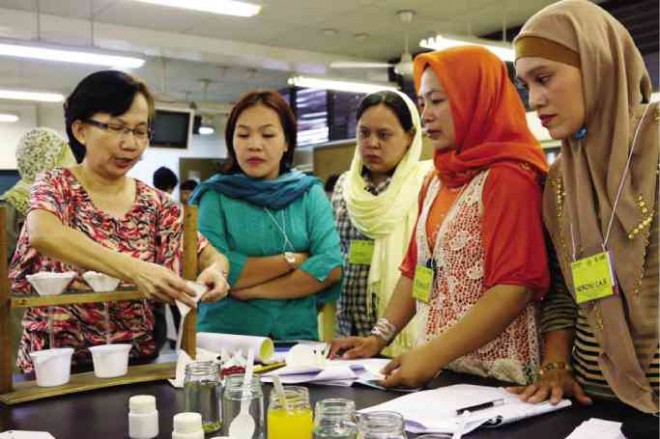Why ARMM students are smiling

ARMM teachers are trained by a representative of UP NISMED to conduct experiments to help students learn science better.
Ask the Maguindanao teachers who have been trained under the Support for the Management of an Improved Learning Environment (SMILE) program if their students are any good and they will say, with conviction, that their students are as good as everyone else.
They say teachers do not have to see a rise in National Achievement Test (NAT) scores to know that their students are learning.
SMILE is a training-of-trainers program funded through the Basic Education Assistance for Mindanao (BEAM), a joint undertaking of the Autonomous Region in Muslim Mindanao’s (ARMM) Department of Education (DepEd) and the Australian Agency for International Development. The University of the Philippines National Institute for Science and Mathematics Education Development (UP NISMED) was commissioned to do the first-line training.
A total of 10,878 teachers have participated; in turn, they will train other teachers in science and mathematics.
“Maguindanao children are not stupid. Their intelligence just needs to be brought to the fore by their teachers,” says Rakma Duga, Grade 1 class adviser at Dalican Pilot Elementary School.
Duga and her colleagues say the teaching approaches they have learned from SMILE are helping them get their students to improve their academic performance. SMILE is a supplement to the DepEd’s K to 12 teacher training.
Thanks to the program, Apple Grace Cadion says she now teaches science using an inquiry-based approach. She is a first grade science teacher-trainer at Nuro Central Elementary School in Upi town, Maguindanao province.
For example, she starts a lesson by showing her students pictures and asking them what they see. She asks open-ended questions to encourage students to think and answer. She then asks them how they came up with their answers. The process allows the children to discover the lesson by themselves, she says.
“You’ll be surprised at how these young children can give such intelligent answers,” says Tarhata Tarapas, who is also a math teacher-trainer and head of Sarmiento South Elementary School in Parang town.
Besides the inquiry-based approach, SMILE has taught the teachers the problem-based approach to math as well as cooperative or group learning, practical work and multiple intelligence approaches.
In the past, teachers dwelt on theory and lacked analysis, says Tarapas. They used “the traditional multiple choice and fill-in-the-blanks approaches that require only memorization.”
Now, her students are thinking critically and communicating better. Both skills are among the 21st-century skills included in the DepEd’s Enhanced K to 12 Basic Education Program to prepare the youth for employment, entrepreneurship or higher education.
Demia Uko, teacher-trainer at Beto Primary School in Datu Odin Sinsuat town, says students in math are now asked to act out problem-solving operations with teaching manipulables for better comprehension. They use plastic cups on strings, for instance, to measure weight and size. They have magnets with which to count sets of ones and tens.
“They can’t seem to put down the devices, even after class,” says Cadion. By using tactile things and with practice, students get to understand math concepts better. “Where I live, the people who are good in math are those who work in the wet market because they get to practice it,” she says.
As teachers, they used to do all the talking, says Tarapas. “We gave all the instructions. Now, we are merely learning facilitators. No more spoon-feeding. We are less stressed and our students are less suffocated.”
The students are more eager to learn. “The Grade 3 teacher in the next classroom was surprised our class was so happy,” Taragas says.
Duga says, “We now have more freedom in our classrooms.” Teachers learn together with their students.
Uko, Cadion and Duga hope that eventually, all teachers in all grade levels would be trained in the SMILE approach.
Grade 8 science teacher-trainer Ferdinand Valdez from Parang National High School is hoping for more teaching materials. BEAM is responding with equipment for science laboratories, secondary school technical-vocational workshops and computer and language labs. It is also establishing school libraries and materials development centers in the region.
The ARMM teachers have high hopes that soon, their schools would no longer be “first from the bottom in NAT results.” And they have even higher hopes—to see their students grow up to be good and competent leaders of the new Bangsamoro.














